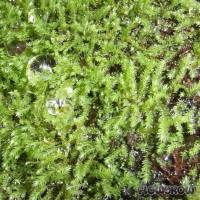



Philonotis hastata is a small moss that is quite common in moist and wet locations in the subtropics and tropics. It forms dense cushions or lawns consisting of tiny, thin, more or less upright-growing, yellow green or pale green, soft water-repellent moss plantlets. The cushions grow on wet substrates or float on the surface of stagnant waters. On the basis of the cushions, a tangled mass of brown rhizoids develops. Philonotis hastata does not survive under water.
This tiny moss can frequently be found in greenhouses of botanical gardens and aquatic plant nurseries. From there it sometimes finds its way into an aquarium, where it shows up spontaneously on the water surface or on things sticking out of the water, like driftwood, filter mats etc.
It reproduces and spreads vegetatively by small modified branchlets (gemmae) that detatch from the mother plant and look like green dust particles to the naked eye. These brood branches float on the water and are thus spread.
Philonotis hastata is not really an aquarium moss, and as a rule, it is not deliberately cultivated. However, its pale green delicate cushions can look quite nice on the water surface or on land parts of open tanks or paludaria and add to the natural feeling of an aquascape.
<a href="https://www.flowgrow.de/db/aquaticplants/philonotis-hastata" target="_blank"><img alt="Philonotis hastata" title="Philonotis hastata" src="https://www.flowgrow.de/db/widget/aquaticplants/philonotis-hastata" /></a>
[url=https://www.flowgrow.de/db/aquaticplants/philonotis-hastata][img]https://www.flowgrow.de/db/widget/aquaticplants/philonotis-hastata[/img][/url]
[widget=aquaticplants/philonotis-hastata]Philonotis hastata[/widget]